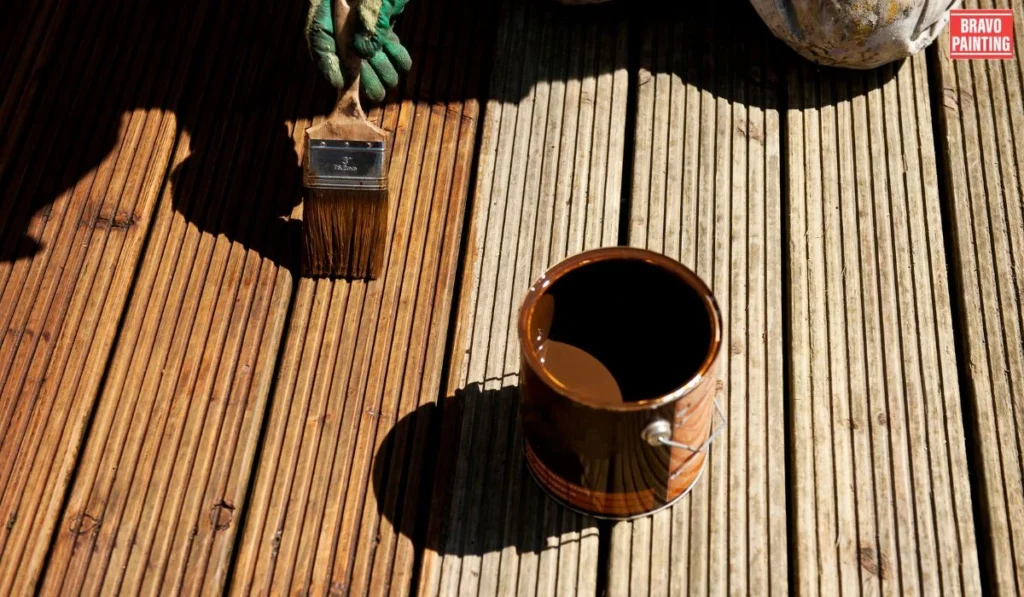Wood staining is one of the crucial elements in wood finishing, which imparts color, depth, and character to the wood surfaces.
Traditional methods of wood staining have long used harsh chemicals and solvents that damage the environment and human health.
The increasing consciousness of the environment has brought an ever-increasing demand for sustainable and eco-friendly practices in all sectors, including professional wood staining.
In this article, we will discuss sustainable wood staining practices, the benefits of using eco-friendly options, and how professional wood staining companies are integrating these practices to ensure a more sustainable future.
What is Professional Wood Staining?
Professional wood staining refers to applying various stains to wood surfaces to enhance the wood’s natural grain while providing protection.
They seep into the wood, coloring it and providing protection against wear and tear from the elements.
Wood stains can be oil-based, water-based, or gel-based and provide different finishes and benefits.
Most of these traditional staining products, however, contain volatile organic compounds (VOCs) that can have damaging effects on the environment and human health.
The Trend Towards Environmentally Friendly Wood Staining
With growing environmental concerns, the wood staining industry has shifted dramatically towards a more environmentally friendly and sustainable operation.
With the increased awareness of consumers on how their purchasing decisions can affect the planet, the professionals in the wood staining industry are forced to adopt more sustainable solutions.
Sustainable wood staining practices involve using materials derived from renewable sources, minimizing waste, and reducing harmful environmental impacts.
These practices not only benefit the environment but also ensure that the wood maintains its natural beauty and durability without causing harm to the ecosystem.
The Environmental Impact of Traditional Wood Staining Practices
It is, therefore, essential to understand first the environmental impact of traditional staining methods before going into eco-friendly options.
Conventional wood stains contain lots of harmful chemicals such as formaldehyde and lead, among others.
These chemicals are released as VOCs into the atmosphere and contribute to air pollution for the environment and its users.
Furthermore, many conventional wood stains are petroleum-based, which makes them rely on non-renewable resources for their production.
They can also contain artificial colorants and preservatives that are toxic to the ecosystem when they leach into the soil or water.
With these concerns in mind, it’s clear that there is a call for sustainable alternatives in professional wood staining.
Eco-friendly staining practices become a means of reducing these harmful environmental impacts while still ensuring beautiful, durable finishes on wood surfaces.
Types of Eco-Friendly Wood Stains
Bio-Based Stains
- Bio-based stains are made from renewable resources, such as plant-based oils, waxes, and resins.
- These stains are free of toxic chemicals, making them safer for the environment and individuals applying them.
- Bio-based stains utilize renewable resources that can be replenished naturally, unlike petroleum-based stains that rely on finite resources.
- Using these stains in professional wood staining promotes environmental sustainability without compromising the quality of the finish.
- Bio-based stains have various shades and finishes, such as light tints to deep rich hues.
- These stains would not likely emit harmful fumes in the air, making for a healthier working environment.
Water-Based Stains
- Water-based wood stains are another very popular, eco-friendly option.
- They utilize water as the primary solvent rather than petroleum-based solvents.
- Thus, they emit a great deal fewer VOCs, making them much safer for use both indoors and outdoors.
- Water-based stains dry faster and have less odor compared to oil-based stains.
- They are, therefore, the preferred choice for professional wood staining services.
- They are also easy to clean up with just soap and water, thus reducing the use of harsh cleaning chemicals.
Non-Toxic and Low-VOC Stains
- For the least harmful options, non-toxic and low-VOC stains are perfect.
These stains are specially formulated to reduce the emission of toxic chemicals and toxins. - Low-VOC stains release fewer pollutants into the air, reducing air quality degradation, while non-toxic options ensure the safety of those handling the materials.
- These stains are often free of heavy metals, phthalates, and other harmful substances.
- They are also biodegradable, meaning that they will break down naturally in the environment, further minimizing their impact on the planet.
Plant-Based and Organic Stains - Plant-based stains are created from natural materials such as soy, linseed, or walnut oil.
- These stains are non-toxic, biodegradable, and derived from renewable plant sources, making them a highly sustainable option for professional wood staining.
- Plant-based stains are ideal for people who want a completely organic solution to wood finishing.
- Organic stains are usually a way of emphasizing the natural wood without affecting the texture or the appearance.
- This finish gives a deep, lustrous shine to wood that suits rustic and modern wood designs.
Recycled and Reclaimed Wood Stains
- While stains themselves can be environmental, another key element of sustainable wood finishing is using reclaimed or recycled wood.
- It is retrieved from old furniture, buildings, and other wooden structures, reducing the demand for new timber and minimizing deforestation.
- This is primarily unique in appearance, giving it a character and texture that cannot be equaled by new wood.
- Using eco-friendly stain products, reclaimed wood can become beautiful, functional furniture or decorative items.
Benefits of Eco-Friendly Wood Staining
Reduced Environmental Harm
- The most important advantage of eco-friendly wood staining is that it reduces environmental harm.
- The use of non-toxic and biodegradable materials reduces the impact of such stains on the environment.
- Eco-friendly stains minimize air, water, and natural resource pollution.
- They will help keep ecosystems intact for future generations.
Healthier Indoor Air Quality
- Many traditional wood stains contain harmful VOCs that get emitted into the air, which contribute to indoor air pollution.
- These fumes can cause headaches, dizziness, and respiratory issues in poorly ventilated spaces.
- Eco-friendly stains have low or no VOCs, making the overall air quality indoors healthier and safer for people working or living in the area.
Improved Safety for Workers
- Professional wood staining mainly involves direct contact with the applied material.
- This reduces the risk of exposure to skin irritation, respiratory health issues, and other toxic chemical-related health problems by using eco-friendly stains.
- This, in turn, helps protect the staff applying the stain, but on completion, ensures that individuals interacting with surfaces after undergoing the staining process will also be ensured safety.
Increased Durability of Wood Surfaces
- Sustainable stains are often made from durable natural materials, such as excellent moisture protection, UV protection, and general wear and tear.
- Eco-friendly wood stains increase the durability of wood surfaces with minimal reapplication needs to maintain their longevity and extend furniture, flooring, and wooden structures’ lifespan.
Enhanced Aesthetic Appeal
- Eco-friendly wood stains enhance the natural beauty of wood while bringing in rich colors and textures.
- They enhance the wood grain, making it warm and inviting for any setting.
- With a wide range of natural shades available, eco-friendly wood stains can be used to achieve both traditional and modern looks, making them versatile for all kinds of projects.

How Professional Wood Staining Services Are Embracing Sustainability
Professional wood staining companies increasingly embrace sustainable practices to meet consumer demand for eco-friendly solutions.
These companies are shifting towards using green products, reducing waste, and adopting energy-efficient methods to minimize their environmental footprint.
Many companies now offer wood staining services that are eco-friendly: using bio-based, water-based, and low-VOC stains, recycling packaging, and using only as much product as possible to minimize waste.
With such sustainability, professional wood staining services can provide high-quality finishes to contribute to a healthier planet.
Conclusion
Integrating environmentally friendly options into professional wood staining is a positive step towards sustainability and environmental responsibility.
Since the advent of bio-based, water-based, low-VOC, and plant-based stains, consumers are able to make choices based on their values without having to compromise on quality or aesthetic appeal.
Professional wood staining companies play a crucial role in making these options more accessible and help preserve the environment while delivering beautiful, long-lasting finishes to wood surfaces.
As the demand for sustainable products rises, the wood staining industry will likely see even more innovations in eco-friendly solutions.
By choosing professional wood staining services that prioritize sustainability, consumers can contribute to a cleaner, healthier, and more sustainable future.
FAQ
Are eco-friendly wood stains as durable as traditional stains?
Yes, the eco-friendly wood stains are just as durable as the traditional stains.
Many eco-friendly stains, like bio-based and plant-based, are made from quality ingredients that provide long-lasting protection and beauty to wood surfaces.
How can I tell if a wood stain is genuinely eco-friendly?
Look for products that are labeled as low-VOC, non-toxic, or biodegradable.
Check for the Green Seal or FSC certification to guarantee that the product meets environmental standards.
Can I use eco-friendly wood stains on any type of wood?
Yes, eco-friendly stains can be applied to most types of wood, including softwoods and hardwoods.
However, it’s always a good idea to test the stain on a small area first to ensure the desired result.
Are water-based stains better than oil-based stains?
Water-based stains are more environmentally friendly because they emit fewer VOCs and dry faster.
Oil-based stains, on the other hand, are sometimes more durable for outdoor applications.
It depends on the specific application.
Can eco-friendly stains be used for interior and exterior wood staining?
Yes, most eco-friendly stains are versatile, meaning you can use them on indoor or outdoor projects.
wood staining

